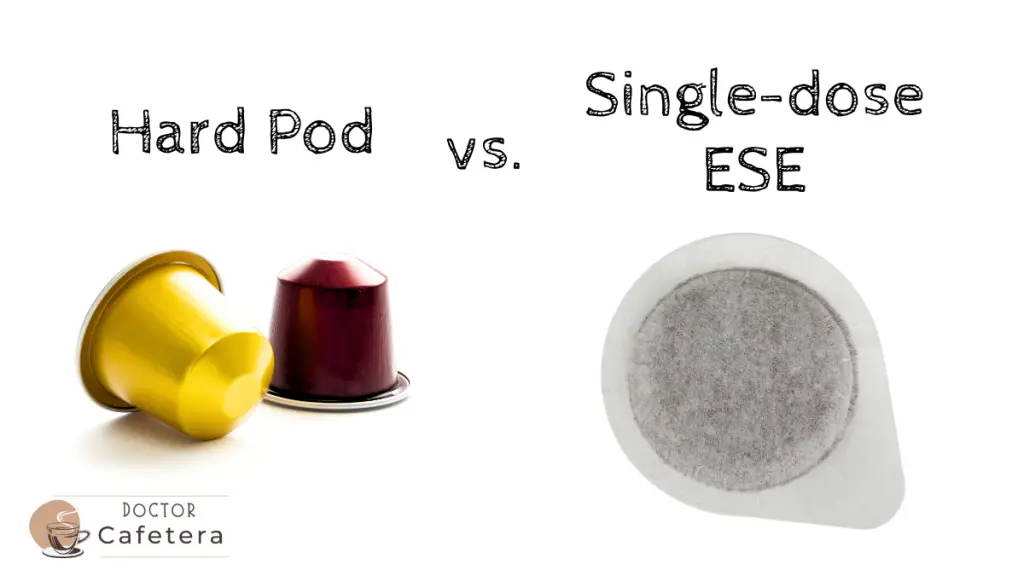Coffee is a very popular beverage worldwide, and for many of us, it is indispensable to start the day with energy. However, preparing coffee with an espresso machine can be complicated and tedious, especially if we do it several times a day.
ESE (Easy Serving Espresso) pods are small pads of ground and pressed coffee that can be used in home espresso machines. This modern, easy-to-use solution has replaced ground coffee in many homes and workplaces.
In this article, I will tell you everything you need to know about ESE pods, from how they work, to the advantages and disadvantages of using them compared to other coffee options.
Difference between coffee pods and ESE single-dose pads
People often think that “coffee pod” and “single-dose” are synonymous, but this is not the case. The different names for the individual packaging of coffee also imply some technical differences.
- Hard coffee pods are solid shells, generally made of plastic material (or aluminum). The coffee extraction is possible thanks to a porous membrane, hermetically sealed.
- On the other hand, single-dose refers to any individual packaging of ground coffee. It covers both hard pods and ESE pads, a kind of tissue sachet mostly made of cellulose.
Apart from this substantial difference, it should be considered that each coffee maker uses a different type of pod. Coffee makers that use ESE pads are unsuitable for hard pods, and vice versa.
The incompatibility is due to different technical specifications, such as weight and overall size. The operating mechanism is specific to each product and varies according to the manufacturer. In other words, each type of single dose requires a specific device.
¿What are “ESE” pods?
Among the many types of coffee pods on the market, one, in particular, carries the abbreviation ESE. It stands for “Easy Serving Espresso”.
The abbreviation ESE is usually followed by a two-digit number (almost always 38 or 44) that indicates the diameter of the pod and provides an additional indication of its compatibility with a specific model of the espresso machine.
The diameter measurement is not accurate to the millimeter but has a tolerance of half a millimeter (the actual measurement, therefore, ranges between 43.5 and 44.5 mm).
The main advantage offered by this type of single-dose coffee, in addition to the possibility of choosing from a wide range of blends offered by the different manufacturers, is the savings since single-dose coffee pods avoid coffee waste.
ESE single-dose: the ecological choice that protects the environment
Single-dose coffee has revolutionized habits and customs, taking espresso out of the traditional places of consumption. Still, it has also generated a new type of waste that is difficult to eliminate, especially when it comes to recycling hard coffee capsules.
According to data from Life Pla4coffee, the European project whose aim is to replace coffee capsules made of Pe (polyethylene), Pet (Polyethylene Terephthalate), or aluminum with biodegradable or compostable capsules, more than 10 billion coffee capsules are sold worldwide each year, generating 120,000 tons of waste, including some 70,000 tons in Europe alone.
Researchers are also concerned about the materials used in the production process of coffee capsules and their significant impact on the environment: suffice it to say that synthetic PE and PET require 15,000 tons of petroleum, a non-renewable energy source, and produce more than 410,000 tons of carbon dioxide.
ESE single-dose coffee represents the green alternative to plastic capsules. It promotes the ecological consumption of one of the world’s most popular beverages without giving up the convenience of single-dose systems: in this way, espresso, in addition to being as creamy and intense as in the coffee shop, also becomes sustainable.
¿What are the advantages of ESE pods?
1. Open system: ESE coffee pods are part of the espresso industry’s only “open” system. They are pre-packaged portions of 7 grams of ground coffee, pressed and hermetically sealed between two thin layers of filter paper.
You can find them in different brands and models, compatible with each other and available in different price ranges.
Unlike closed systems, which do not allow the use of other products from outside a specific brand, thanks to the Easy Serving Espresso brand on espresso coffee makers and single-dose coffee containers, consumers can identify the compatibility between both products and choose the ones that best suit their needs;
2. Extraction: ESE pods greatly facilitate the extraction of coffee since the water does not have to pass through resistant materials, such as plastic or aluminum, but a thin 100% vegetable paper wrapper that does not release any residue.
Extraction is the method used to prepare the coffee from the capsules: a water flow at about 198°F and a pressure of about 9 – 12 bar passes through the ground coffee in the right granulometry and reaches the cup, turning it into a full-bodied and aromatic coffee.
3. Eco-sustainability: paper capsules are a biodegradable product, easy to dispose of in the trash bin, and environmentally friendly.
There are also 100% ecological single-dose pods on the market with outer packaging that can be recycled in paper containers.
4. Savings: It is also worth mentioning that the absence of plastic and aluminum reduces costs: ESE single-dose pods, in fact, cost, on average less than plastic or aluminum coffee capsules.
¿Where can I buy ESE pods?
ESE pods, like capsules, can be conveniently purchased online through stores such as Amazon.
Digital stores allow you to shop from the comfort of your home anytime and have the technical specifications of the many products on the market to choose more precisely what you want to buy.
Alternatively, it is possible to go to specialized physical stores that sell products related to the world of coffee.
